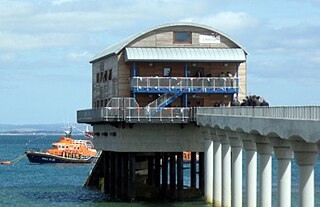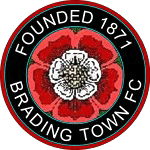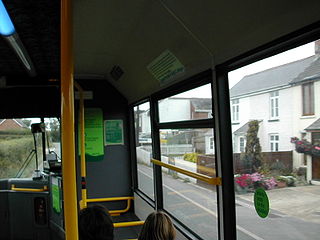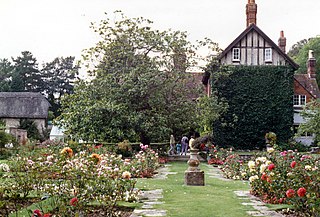
Bembridge is a village and civil parish located on the easternmost point of the Isle of Wight. It had a population of 3,848 according to the 2001 census of the United Kingdom, leading to the implausible claim by some residents that Bembridge is the largest village in England. Bembridge is home to many of the Island's wealthiest residents. The population had reduced to 3,688 at the 2011 Census.

The ancient 'Kynges Towne' of Brading is the main town of the civil parish of the same name. The ecclesiastical parish of Brading used to cover about a tenth of the Isle of Wight. The civil parish now includes the town itself and Adgestone, Morton, Nunwell and other outlying areas between Ryde, St Helens, Bembridge, Sandown and Arreton. Alverstone was transferred to the Newchurch parish some thirty years ago.

The Isle of Wight Railway was a railway company on the Isle of Wight, United Kingdom; it operated 14 miles of railway line between Ryde and Ventnor. It opened the first section of line from Ryde to Sandown in 1864, later extending to Ventnor in 1866. The Ryde station was at St Johns Road, some distance from the pier where the majority of travellers arrived. A tramway operated on the pier itself, and a street-running tramway later operated from the Pier to St Johns Road. It was not until 1880 that two mainland railways companies jointly extended the railway line to the Pier Head, and IoWR trains ran through, improving the journey arrangements.

The River Yar on the Isle of Wight, England, rises in a chalk coomb in St. Catherine's Down near Niton, close to the southern tip of the island. It flows across the Lower Cretaceous rocks of the eastern side of the island, through the gap in the central Upper Cretaceous chalk ridge of the Island at Yarbridge, then across the now drained Brading Haven to Bembridge Harbour in the northeast.

Nunwell is the location of Nunwell House, near Brading on the Isle of Wight, which was the home of the Oglander family for many centuries. It is in the civil parish of Brading. The present family are not direct descendants through the male line and thus the baronetcy has died out.

Brading Town Football Club is an English football club based in Brading, Isle of Wight. They are currently members of the Isle of Wight League Division One and play at the Peter Henry Ground.

Brading railway station is a Grade II listed railway station serving Brading on the Isle of Wight, England. It is located on the Island Line from Ryde to Shanklin. Owing to its secluded countryside location, it is one of the quietest stations on the island.

Sandown Castle was a Device Fort built at Sandown on the Isle of Wight by Henry VIII in 1545 to protect against the threat of French attack. Constructed from stone with angular bastions, its design was a hybrid of Italian military architectural thinking with traditional English military design. The site was raided by a French force that summer while the fortification was still being constructed. The site suffered from coastal erosion and the castle was demolished in 1631.

Yarbridge is a hamlet on the Isle of Wight, England. It is at the southern tip of the parish of Brading. It has a popular pub restaurant called the Yarbridge Inn. There is also a small hotel with a swimming pool, Oaklands House. The bridge over the River Yar, defended by a Second World War pillbox, was constructed in the Middle Ages by Sir Theobald Russell who was killed fighting a French invasion, dying of his wounds at Knighton Gorges. Until the bridge's construction, Bembridge had been an island accessible only at low tide. The bridge also crosses the railway and is bordered by an RSPB reserve on Brading Marshes.

Brading Roman Villa was a Roman courtyard villa which has been excavated and put on public display in Brading on the Isle of Wight.
Mersley is a farming hamlet on the Isle of Wight. Mersley is in Newchurch Parish, and is adjacent to the village of Newchurch itself. Mersley is home to a large garlic farm which is part of the Isle of Wight Garlic Festival in nearby Newchurch, held annually since 1983 and now drawing 25,000 visitors a year. This garlic farm has also been investigated for inappropriate pesticide use in the past.

St Helen's with its 232-foot-long (71 m) single platform was the only intermediate stop on the 2+3⁄4-mile (4.4 km) branch line that connected Brading to the coast at Bembridge.

Bembridge was the terminus of the 2+3⁄4-mile branch line that connected it to the main line at Brading. On holiday Saturdays the sector table revolved continuously because the station area was too small to contain points.

Gaskins is a hamlet on the Isle of Wight in England UK. It is on the B3330, approximately 1 mile (1.6 km) West of St Helens, and approximately 2 miles (3.2 km) Northeast of Brading.

Morton Manor is a manor house originating in the 13th century, in Brading, Isle of Wight, England. It is located 1 mile (1.6 km) southwest of Sandown Road. The fairly small 14th-century house was modified in the 19th century. Constructed of varied materials, it was refurbished and extended in the early 20th century in an Arts and Crafts style. The house has a Tudor fireplace in the dining room, with William De Morgan green glazed tiles, and the manor includes a small museum of rural life.

Nunwell House, also Nunwell Manor, is a historic English country house in Brading, Isle of Wight. Located 3 miles (4.8 km) south of Ryde, the Tudor and Jacobean style house also has later additions. The house contains family militaria. It was occupied by the Oglander family from Norman times. Nunwell House is a Grade II* listed building.
Hill Farmhouse is an English country house in Brading, Isle of Wight. The 17th century farmhouse, a Grade II listed building, is located on Carpenters Road. It was constructed of local limestone. While the two storey gabled porch was an addition, the mullioned window to the left of the porch is an original. An arched doorway is Tudor style.















